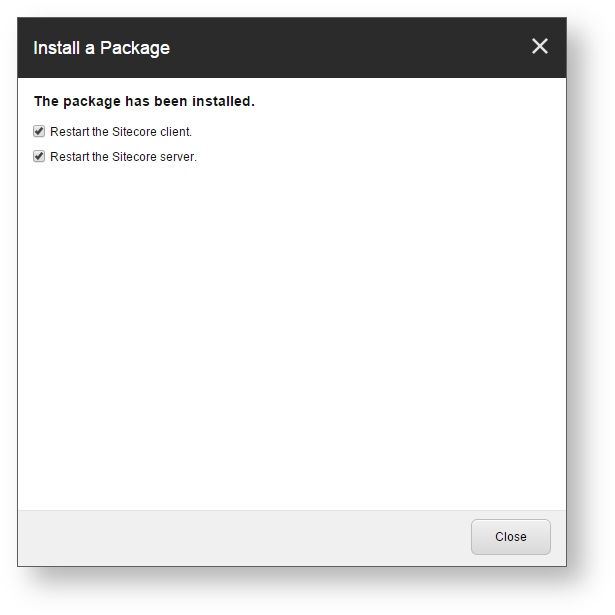Upgrading from June 2017 to July 2017
Upgrading from June 2017 to July 2017
For the best Coveo for Sitecore experience, always follow the Leading Practices When Upgrading Coveo for Sitecore.
This section describes how to upgrade Coveo for Sitecore 4.0 from the June 2017 to the July 2017 release.
Step 1: Upgrade Coveo Services
-
Ensure that you have installed the June 2017 release of Coveo Enterprise Search (CES 7.0.8996). For more details, see Upgrading CES.
-
Ensure that you have installed the March 2017 release of the Coveo Search API (8.0.1134).
Step 2: Upgrade Coveo for Sitecore
Ensure that the Microsoft MVC security update MS14-059 is installed on every Sitecore host in your environment.
If you’re using the Coveo Admin Service in secure mode, read this notice before installing the package.
In the Coveo.SearchProvider.config file, make sure that the AdminServiceUri value uses the same host name as the one specified in the certificate. If you’re using a different host name, such as localhost, you might get the error below when installing the package.
The remote certificate is invalid according to the validation procedure.
...
[WebException: The underlying connection was closed: Could not establish trust relationship for the SSL/TLS secure channel.]
...
[SecurityNegotiationException: Could not establish trust relationship for the SSL/TLS secure channel with authority 'localhost'.]
-
Log into the Sitecore Desktop.
-
Access the Installation Wizard (Sitecore Start Menu > Development Tools > Installation Wizard).
-
Install the Coveo for Sitecore .zip package.
-
When prompted to overwrite files, click Yes to all.
-
When prompted to overwrite items, select Overwrite, then click Apply to all.
You might be prompted twice with this question. Select the Overwrite option and click Apply to all both times.
-
Once the installation is completed, make sure that you restart both the Sitecore client and server.

Step 3: Manually Update the Coveo Search Provider Configuration File
Step 1: Upgrade Coveo for Sitecore
Ensure that the Microsoft MVC security update MS14-059 is installed on every Sitecore host in your environment.
-
Log into the Sitecore Desktop.
-
Access the Installation Wizard (Sitecore Start Menu > Development Tools > Installation Wizard).
-
Install the Coveo for Sitecore .zip package.
-
When prompted to overwrite files, click Yes to all.
-
When prompted to overwrite items, select Overwrite, then click Apply to all.
You might be prompted twice with this question. Select the Overwrite option and click Apply to all both times.
-
Once the installation is completed, make sure that you restart both the Sitecore client and server.

Step 2: Manually Update the Coveo Search Provider Configuration File
Merging Your Modifications into the Configuration Files
Since upgrading Coveo for Sitecore modifies the Coveo Search Provider configuration files (Coveo.SearchProvider.config.example and Coveo.SearchProvider.Custom.config.example) with the latest fixes and enhancements, you need to manually merge these modifications into your current configuration files (Coveo.SearchProvider.config and Coveo.SearchProvider.Custom.config). This method allows you to keep your own customization intact, while still benefiting from the latest enhancements brought in the product. You can use a merge tool such as WinMerge to do that.
Coveo.SearchProvider.config
-
In the
factoriesnode, after thefactoryelement with theremoteListFactoryid, add the following elements:<factory id="excludedFieldsFactory" type="Coveo.SearchProvider.FirstAvailableRemoteListFactory, Coveo.SearchProviderBase"> <xpaths hint="list:AddXPath"> <xpath name="Lucene">contentSearch/indexConfigurations/defaultLuceneIndexConfiguration/documentOptions//exclude[@hint='list:AddExcludedField']</xpath> <xpath name="Solr">contentSearch/indexConfigurations/defaultSolrIndexConfiguration/documentOptions//exclude[@hint='list:AddExcludedField']</xpath> <xpath name="Azure">contentSearch/indexConfigurations/defaultCloudIndexConfiguration/documentOptions//exclude[@hint='list:AddExcludedField']</xpath> </xpaths> </factory> -
In the
coveoGetContextCoveoIndexelement, at the end of the list of processors, add the following element:<!-- Processor used to fallback on an index when the current context item isn't a valid Indexable. --> <processor type="Coveo.SearchProvider.Processors.FallbackOnFirstIndexWithSameDatabaseProcessor, Coveo.SearchProvider" /> -
In the
coveoelement, after thecloudPlatformcommunicationFactoryelement, add the following element:<databasePropertyStore type="Sitecore.ContentSearch.Maintenance.IndexDatabasePropertyStore, Sitecore.ContentSearch"> <Key>$(1)</Key> <Database>core</Database> </databasePropertyStore> -
Locate this configuration element:
<exclude hint="list:AddExcludedField" ref="contentSearch/indexConfigurations/defaultLuceneIndexConfiguration/documentOptions//exclude[@hint='list:AddExcludedField']" factory="remoteListFactory"/>Replace it with the following element.
<exclude hint="list:AddExcludedField" ref="mandatory, don't delete" factory="excludedFieldsFactory" /> -
Locate these configuration elements:
<coveoSyncMaster name="CoveoSyncMaster" ref="contentSearch/indexConfigurations/indexUpdateStrategies/syncMaster" /> <coveoOnPublishEndAsync name="CoveoOnPublishEndAsync" ref="contentSearch/indexConfigurations/indexUpdateStrategies/onPublishEndAsync" />Replace them with the following elements:
<coveoSyncMaster name="CoveoSyncMaster" type="Sitecore.ContentSearch.Maintenance.Strategies.SynchronousStrategy, Sitecore.ContentSearch"> <param desc="database">master</param> </coveoSyncMaster><coveoOnPublishEndAsync name="CoveoOnPublishEndAsync" type="Sitecore.ContentSearch.Maintenance.Strategies.OnPublishEndAsynchronousStrategy, Sitecore.ContentSearch"> <param desc="database">web</param> <CheckForThreshold>true</CheckForThreshold> </coveoOnPublishEndAsync> -
In the
ContentSearchelement, locate this configuration element:<coveoSyncMaster name="CoveoSyncMaster" ref="contentSearch/indexConfigurations/indexUpdateStrategies/syncMaster" /> <coveoOnPublishEndAsync name="CoveoOnPublishEndAsync" ref="contentSearch/indexConfigurations/indexUpdateStrategies/onPublishEndAsync" />Replace it with the following elements:
<coveoSyncMaster name="CoveoSyncMaster" type="Sitecore.ContentSearch.Maintenance.Strategies.SynchronousStrategy, Sitecore.ContentSearch"> <param desc="database">master</param> </coveoSyncMaster> <coveoOnPublishEndAsync name="CoveoOnPublishEndAsync" type="Sitecore.ContentSearch.Maintenance.Strategies.OnPublishEndAsynchronousStrategy, Sitecore.ContentSearch"> <param desc="database">web</param> <CheckForThreshold>true</CheckForThreshold> </coveoOnPublishEndAsync> -
In the
contentSearchelement, between theindexConfigurationsand theconfigurationelements, add the following element:<!-- The configuration element appears twice for these reasons: 1. If no other search provider is defined, the type needs to be specified to create the configuration element. 2. If an other search provider is configured already and overrides the type of the configuration element, Coveo indexes are added to the same configuration element as other indexes. --> <configuration type="Sitecore.ContentSearch.ContentSearchConfiguration, Sitecore.ContentSearch" /> -
Locate this configuration element. It should appear twice in your file.
<propertyStore ref="contentSearch/indexConfigurations/databasePropertyStore" param1="$(id)"/>Replace both occurrences with this element:
<propertyStore ref="coveo/databasePropertyStore" param1="$(id)"/>